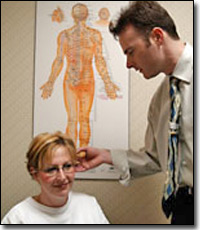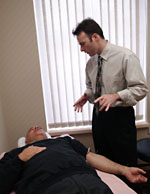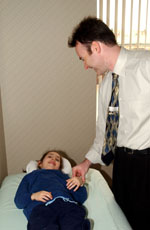How Treatment Works and Why Do I Suffer from Migraine?
- The problem is how nerves are talking.
The main cause of migraine is an individual's slow reaction to specific internal or external environmental changes. Physiological reactions take place constantly in response to our body's needs. These responses are communicated through the nervous system to direct and coordinate proper function of our cells, organs and systems. The way that nerves communicate with one another is by releasing chemical messengers called neurotransmitters.
Any physiological adjustment that needs to take place requires the correct amount of neurotransmitter at the appropriate time. Sometimes with decreased function this release is too fast or slow, too much or too little, and this can lead to inaccurate or delayed adjustment in function.
With function suffers, the delayed adjustment can last hours or even days. Eventually the correction is made and function returns to normal. Migraineures have normal adjustment of neurotransmitter under virtually every situation but a few, and those are referred to as triggers.
There are thousands of triggers for migraine, but usually only a few affect an individual. It is important to understand that the trigger is not the problem, but rather the individual's diminished ability to respond fast enough to what that trigger is requiring them to do.
For example, foods that we eat cause a cascade of physiological events to use the nutrients we digest. The different nutrients cause different neurotransmitters to be released so that the body can perform the correct function to utilize the food properly. This balancing of transmitters is different with different foods. Foods that are referred to as a trigger, challenge the individual's ability to balance transmitters in the correct amount. The inappropriate transmitter balance leads to the symptoms of migraine. This balance is eventually achieved and the symptoms retreat until the next difficult challenge.
- Why Do I Have Difficulty with Balancing Transmitters?
Our nervous system adjusts to adapt to the challenges that we knowingly or unknowingly expose it to. Some examples would be weather, food, stress, hormones, the way we think, how much sleep we get, exercise, what we smell and anything else you can think of. Routines that we develop alter or stress certain parts of our nervous system become better at reacting, while others weaken. Those weak links can leave us vulnerable.
The treatment is so successful because of the nature of your nervous system. Understanding that your nervous system is ever learning and is adaptable to changes is the first step in understand how acupuncture works. The weak links that develop will only improve if stimulated or trained. Depending on an individuals lifestyle, different nervous system strengths and weaknesses will arise.
Proper assessment of an individual's health can pin-point the areas that need improvement. Selecting the specific acupuncture points will target the weaker areas and stimulate them to regain optimal function.
Our nervous system is designed to be stimulated and give a similar response in many ways. Going outside on a cold day or having someone scratch fingernails on a chalkboard will cause shivering. Biting into a cold lemon or just thinking about it can cause the same response of salivating. This is a similar mechanism of how acupuncture can stimulate a desired response that will train the nervous system towards optimal health.
Treatment Protocol
A course of treatment involves a minimum of two treatments per week. The treatments may be received more frequently eg. 2-3 treatments per day (there must be a minimum of two and a half hours between treatments). This “stacking” of treatments is useful for those that are traveling a great distance to receive treatment. This increased frequency of treatment will shorten the number of weeks that treatment is needed as well as reduce the number of weeks that medication is required.
The treatment that is administered at The Ontario Migraine Clinic is a form of acupuncture that is only offered at the Georgetown and Toronto locations. The Ontario Migraine Clinic has been awarded as the most successful migraine clinic in the world. This award was received in December 2000 from The Open University of Complementary Medicine.
There is no contra-indication for receiving this treatment, and it will not interfere with any other treatments that are being received. We encourage discussion about any other treatment you may be receiving that is concurrent with your treatment at The Ontario Migraine Clinic.
The number of weeks and treatments will vary greatly from person to person. Factors that will influence the number of weeks/treatments will be severity of condition, medication, compliance with treatment requirements as well as other health issues that may impede progress. All of these factors will be discussed on an individual basis.
Initial Consultation :
-
Registration in the clinic:
Once registered, you will always be assured appointment times during regular office hours. -
Review of assessment forms with practitioner.
-
Review of any previous assessment material,x-rays, reports, etc.
-
Physical assessment to determine starting point of the treatment that will be provided.
-
Discussion of findings and explanation of issues and the treatment protocol.
-
Commencement of treatment program to include first treatment.
-
Review of post treatment findings and discussion of expectations:
Explanation of what to expect during treatment at The Ontario Migraine Clinic.
Second visit until re-evaluation
From the initial consultation to the re-evaluation there will be a progression in the treatments administered ie., each treatment builds upon the last.
Until treatments are completed, migraines may persist, but usually the frequency, intensity and symptoms will diminish as the program advances. Changes in symptoms is what is important at this stage as this is a great indicator that your system is learning how to "fight" differently.
Re-evaluation
Another assessment is done at this point. Migraines have been reduced or eliminated at this point. Individuals that may still be experiencing some symptoms may require some additional treatment.
The re-evaluation takes place at different intervals from person to person as the treatment are tailored for each individual's needs.
Completion of Treatment
Once the treatment program is completed, there will be several follow-up sessions to insure that the individual maintains the gains that they have achieved.
This will be discussed on an individual basis as each situation is unique.
What Now?
Upon completing the program, when proper health is regained, you may choose to periodically have a check up. This is a valuable investment of your time and is advised. Good health is our choice!



